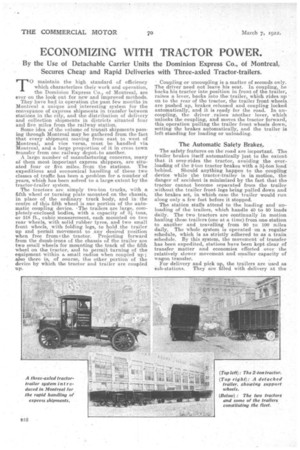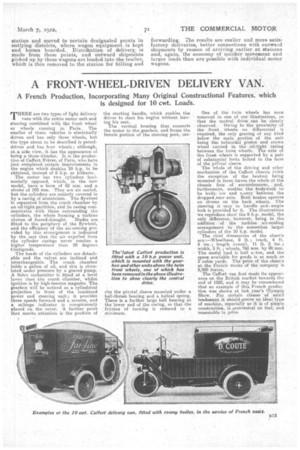ECONOMIZING WITH TRACTOR POWER.
Page 10

Page 11

If you've noticed an error in this article please click here to report it so we can fix it.
By the Use of Detachable Carrier Units the Dominion Express Co., of Montreal, Secures Cheap and Rapid Deliveries with Three-axled Tractor-trailers.
0 maintain the high standard of efficiency -which characterizes their work and operation, the Dominion Express Co.., of Montreal, are ever an the look out for new and improved methods. They have had in operation the past few months in Montreal a unique and interesting system for the conveyance of express shipments in transfer between stations in the city, and the distribution of delivery and collection shipments in districts situated four and five miles from the railway station.
Some idea of the volume of transit shipments passing through Montreal may be gathered from the fact that every shipment moving from east to west of Montreal, and vice versa, must be handled via. Montreal, and a large proportion of it in cross town transfer from one railway depot-to another.
A largo number of manufacturing concerns, many of them most important. express shippers, are situated four or five miles. from the stations. The expeditious and economical handling of these two classes of traffic has been a -problem_ for a number of years, which has been solved to a large, extent by the tractor-trailer system.
The tractors are simply two-ton trucks, with a fifth wheel or turning plate mounted on the chassis, in place of the ordinary truck body, and in the centre of this fifth wheel is one portion of the automatic coupling device. i The trailers are large, com
pletely-enclosed bodies, with a.capacity of tons, or 518 ft., cubic measurement, each mounted on two rear wheels, with solid rubber tyres, and two small front wheels, with folding legs, to hold the trailer up and permit movement to any desired position when free from et the tractor. Projecting forward from the dumb-irons of the chassis of the trailer are two small wheels for mounting the track of the fifth wheel on the tractor, and to permit turning of the equipment within a. small radius when coupled up ; also there is, of course, the other portion of the device by which the tractor and trailer a-re coupled up. Coupling or uncoupling is a matter of seconds only. The driver need not leave his seat. In coupling, he backs his tractor into position in front of the trailer, raises a, lever, backs into the•trailer, which rides up an to the rear of the tractor, the trailer front wheels are pushed up, brakes released and coupling locked automatically, and it is ready for the road. In uncoupling, the driver .raises another lever, which unlocks the coupling, and moves the tractor forward, this operation pulling the trailer front wheels down, setting the brakes automatically, and the trailer is left standing for loading or unloading.
The Automatic Safety Brakes,.
The safety features on the road are important. The trailer brakes itself automatically just to the extent that it over-rides the tractor, avoiding the overloading of the 2-ton tractor brakes with a 31-ton load behind. Should anything happen to the coupling device while the tractor-trailer is in motion, the danger of accident is minimized by the fact that the tractor cannot become separated from the trailer without the trailer front legs being pulled down and the brakes set, in which case the trailer would run along only a few feet before it stopped.
The station staffs attend to the loading and unloading of the trailers, which handle 40 to 50 loads daily. The two tractors are continually in motion hauling these trailers (one at a time) from one station to another and travelling from 90 to 100 miles daily. The whole system is operated on a regular schedule, which is as strictly adhered to as a train schedule. By this system, the movement• of transfer has been expedited, stations have been kept clear of transfer matter and economies effected over • the relatively slower movement and smaller capacity of wagon transfer.
For delivery and pick up, the trailers are used as
hub-stations. They are filled with delivery at the station and moved to certain designated points in outlying districts, where wagon equipment is kept and horses boarded. Distribution of delivery, is made from these points, and outward shipments picked up by these wagons arc loaded into the trailer, which is then removed to the station for billing and
forwarding. The results are earlier and more satisfactory deliveries, better connections with outward • shipments by reason of arriving earlier at stations and, again, the economy of quicker movement and larger loads than are possible with individual motor wagons.






























